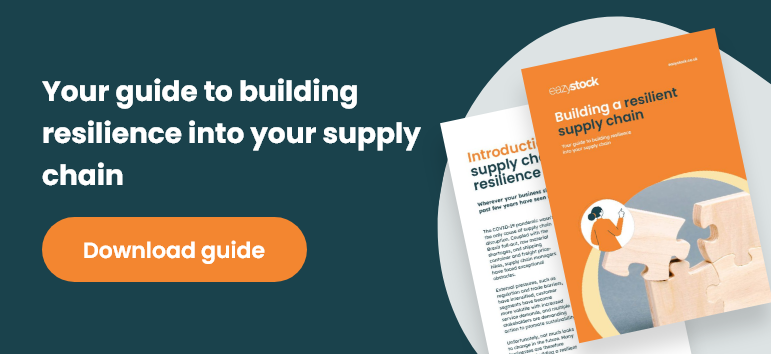Sustainable Supply Chain Management Software
Improving businesses and the environment
In today’s fast-paced business landscape, inventory management plays a crucial role in determining a company’s success. Whether a small retailer or a large-scale manufacturer, getting your inventory right can significantly impact your bottom line. While you strive for efficiency and profitability, have you considered the environmental impact of your inventory practices?
Last month, Hurricane Idalia swept through Florida and several other states in the southeast, forcing airports, marine cargo ports, and distribution hubs to cease or reduce operations. These disruptions caused delays throughout the entire supply chain as effects rippled down. As climate change continues to affect the environment, impactful storms and weather are going to become more frequent.
It’s vital for the environment that we review supply chain and inventory management practices to ensure the environment’s survival and prevent supply chain disruptions. Do you have sustainability goals?
In this blog, we’ll explore how sustainable inventory management can not only boost your business but also contribute positively to the environment. We’ll also highlight some green supply practices you can implement to build a sustainable supply chain.
The hidden cost of inefficient inventory management
Let’s face it – managing inventory can be a logistical nightmare. Relying on spreadsheets and outdated systems often leads to errors, overordering, and excessive transportation, resulting in increased waste and higher carbon emissions. Cutwel, a leading UK-based precision engineering cutting tool distributor, faced similar challenges with multiple spreadsheets and unclear lead times. Fortunately, they found a solution that revolutionized their operations and optimized their inventory while positively impacting the environment.
How sustainability transforms inventory practices
• Improved forecasting: One of the key features of a data-centric solution is its ability to predict future demand more accurately. Instead of relying on historical sales data, it considers various factors, such as market trends and real-time data. This enables businesses to make informed decisions on inventory levels, reducing unnecessary production and transportation.
• Streamlined operations: Say goodbye to the days of manual tracking and endless spreadsheets. Data-driven systems offer near real-time visibility into your inventory, making managing stock levels and planning efficient restocking easier. This not only saves time and resources but also contributes to a more sustainable approach.
• Fewer stockouts, less waste: Businesses can significantly reduce stockouts with better forecasting and optimized stock levels. Having the right stock levels means fewer emergency orders and expedited shipping, translating to less packaging waste and an eco-friendlier supply chain.
• Minimized transportation impact: Optimizing stock levels and reducing emergency orders allows businesses to minimize the number of dispatches and deliveries. Fewer shipments lead to less fuel consumption, lower carbon emissions, and a positive step towards sustainability.
The game-changer: Data-fueled inventory solutions
Cutwel implemented EazyStock, a data-driven software solution that takes inventory management to the next level through inventory optimization, towards the end of 2022. An inventory optimization tool harnesses the power of historical and near real-time data to analyze trends, forecast demand, and optimize stock levels. By adopting this type of solution, businesses can say goodbye to stockouts, reduce packaging waste, and minimize their carbon footprint by lowering shipping frequency.
With better structure to your ordering processes, you can provide suppliers with timely, consistent order information. They can combine your orders into batches, which reduces the number of shipments and help you fill shipping containers.
Shifting towards a greener future
Software plays a crucial role in sustainable supply chain policy, but combining it with other sustainable supply chain initiatives to build a green supply chain can bring even more business success while benefitting the environment.

How to achieve a sustainable supply chain
Now, let’s delve into the practical steps you can take to pave the way for a more sustainable business model.
1. Where are your sustainability supply chain issues?
Reviewing inventory management practices is an excellent place to start. Break down your supply chain into its components and identify where to improve. Before switching inventory management practices, review your long-term goals and business plans to ensure you stay on track.
Sustainable supply chain practices
You might have invested in more stock or increased your rush orders to combat supply chain disruption and uncertainty to meet unexpected demand.
This is expensive and can lead to wasted stock. As supply chains become more stable, switching to proactive, lean inventory management practices, such as just-in-time, reduces waste, carrying costs and risks of obsolete inventory.
Switching from reactive to proactive inventory management puts you in control. The best way to do this is through accurate forecasting. Accurate demand forecasting allows you to proactively take charge of your inventory levels, so you can inform suppliers ahead of time and prepare contingency plans, so you don’t take costly reactive measures.
Sustainable energy and transportation
The most significant CO2 contributors are your power and transportation. By monitoring your use of power and its source, you can highlight inefficiencies and opportunities for power redistribution or a change in power source. Some simple changes include changing to LED lights and fitting motion-sensor lighting.
If you have fleets, consider updating to electric or solar-powered vehicles to reduce your carbon footprint. This could be done incrementally as your vehicles come to the end of their lifecycle. Are your navigation or route planning systems finding the most efficient delivery routes? You could identify wasted mileage that you could cut out to reduce fuel consumption, saving money and CO2 emissions.
Energy-efficient warehouses
How energy-efficient are your warehouses? Could you insulate them to prevent heat and energy from escaping? Specialist doors can keep the warmth in during winter and ensure climate control works properly in warmer months. With wind and weather-proof options that can close quickly, there are multiple options to make your warehouses energy efficient.
Sustainable packaging
How environmentally friendly is your packaging and distribution? If you use a lot of single-use plastic, are there alternatives you could use? Consider how you dispose of packaging and waste from your suppliers or warehouses. Can you recycle or reuse any of the materials?
2. Consider the circular economy
The circular economy involves finding ways to extend the lifecycle of products or their components. This could be through sharing, leasing, reusing, repairing, refurbishing or recycling materials for as long as possible. This reduces waste and encourages sustainable practices. As prices for raw materials increase, it also helps cost savings.
3. Engage suppliers
Your suppliers are fundamental to sustainability if you’re building a green supply chain. As well as preparing your business, you need to understand their practices and how they impact your quest to reduce your carbon footprint.
You should review your suppliers regularly, ranking them on various factors, including lead times, location and environmental considerations. Location will be critical. Recent supply chain disruptions have shown that relying on low-cost suppliers in far-reaching countries is risky. This led to an increase in companies reshoring, nearshoring and multishoring their suppliers to bring more options and reduce any supply chain disruption. It will minimize disruption, and having closer suppliers will reduce your carbon footprint.
What’s the cost impact of a sustainable supply chain?
Sustainability can seem expensive when considering changing the different parts of your inventory management. However, once you’ve highlighted where you can make improvements, you can set and prioritize objectives with timelines, so you aren’t doing everything at once.
As we highlighted above, it’s also crucial to remember that making sustainability changes will bring cost savings. For example, while implementing new software can seem expensive, Cutwel found that EazyStock paid for itself within a month and a half. They continue seeing savings from fewer stockouts and orders alongside increased sales.
Conclusion
As we’ve seen in the case of thriving precision engineering cutting tool distributor, Cutwel, implementing inventory optimization software can revolutionize how businesses operate and support sustainable business practices.
By embracing data-driven solutions like EazyStock, companies can achieve better resource usage, improved on-shelf availability, and significant cost savings. Beyond business benefits, these eco-conscious practices contribute to a greener, more sustainable future for our planet.
So, challenge yourself to consider the positive impact improved inventory practices can have on your profit margin and the environment. Embrace sustainability, optimize your inventory, and become a trailblazer for responsible business practices.








